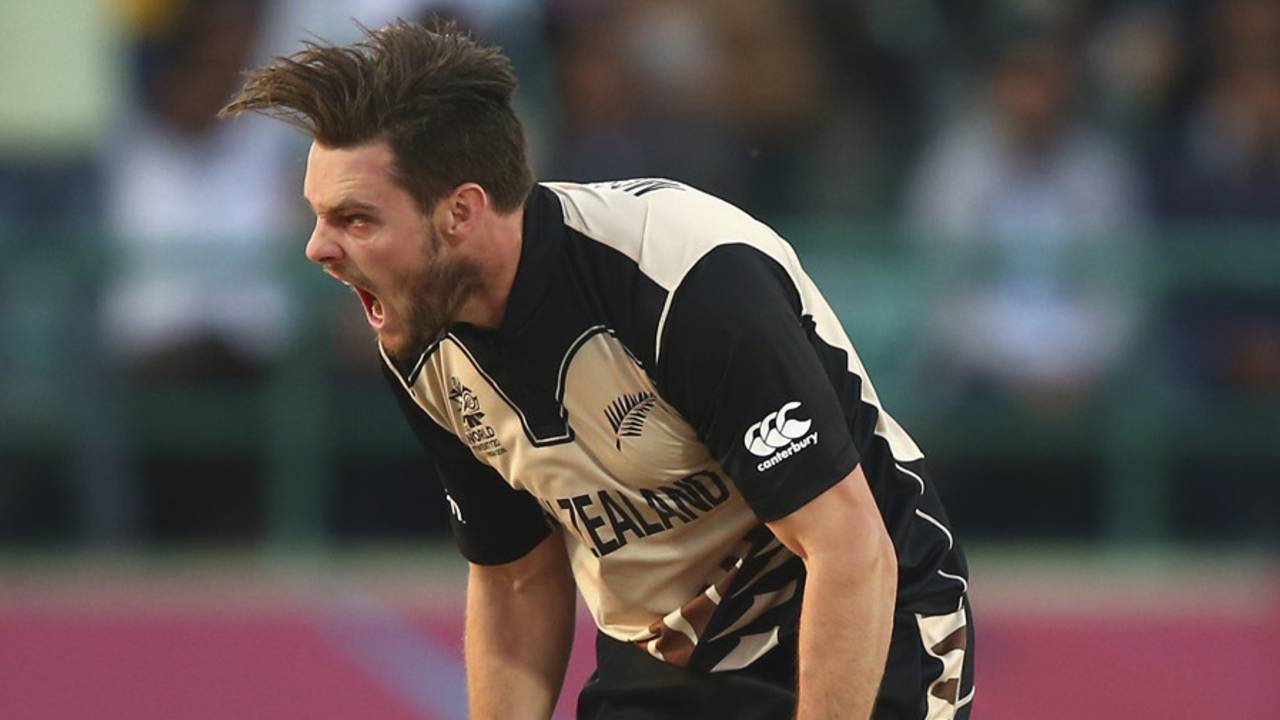We assessed right lengths in first few overs - McClenaghan
New Zealand quick Mitchell McClenaghan said after their eight-run win against Australia that they knew what lenghts to ball on, as early as two-three overs into the match
Sidharth Monga in Dharamsala
18-Mar-2016
Getty Images
Early doors into the warm-ups, on a beautiful sunny day bucking all forecasts, it was apparent New Zealand were going to be unchanged from the XI that stunned India in Nagpur. This was not an identical pitch but similar: the only grass it is likely familiar to is of the kind that brings tourists from far and wide to the Himalayas, and the only pace and bounce it has seen is that of the tireless groundstaff trying to get games in during the rain. Slowness was going to be the theme of the day as might suit the surroundings.
Mike Hesson and Kane Williamson, though, saw something in the pitch, and decided to play Mitchell McClenaghan in place of Nathan McCullum, who had set the pace - or lack of it - for New Zealand with Shikhar Dhawan's wicket in the first over of their defence of 126. So belatedly, long after every other bowler had done so, McClenaghan came out to mark his run-up.
"I knew [I was playing] when I went to the toilet and walked back and saw it on the white board. It was quite late doors," McClenaghan said. He went on to be the Man of the Match banging cutters in the middle of the pitch, bowling the 19th over for two wickets and three runs to shut Australia out of a chase of 143.
New Zealand's success so far is a success of execution from the bowlers all right, but their think tank has made choices that have been spot on. They have read the pitches perfectly. It becomes all the incredible because the first look they got of the square in Dharamsala was about two-three hours before the match; the ground was completely covered because of the incessant rain on Thursday.
Twenty20, because of it short duration, is a lot about assessing conditions early, almost freakishly early. Mike Hussey used to do that with the bat. Mike Hesson seems to be doing it as a coach. His boys are not too far behind, though. As early as two overs into the game, even though Martin Guptill was going bang bang, McClenaghan knew he was not going to bowl full or yorkers or fast.
"It was pretty early," McClenaghan said of the change in the mindset. "I walked over after [Shane] Watson's second over or halfway through the first. We were thinking about and talking… early into the game you have got to assess these kind of things. Walked over to Timmy [Southee] and Boulty [Trent] and Nath [McCullum] and kind of picked their brain. We basically, early, probably three overs into the game, realised it was not a yorker wicket. It was really hard to time off back of a length and cutters and change-ups. Every time someone went on pace they got pumped. That assessment was made pretty early."
Last-minute change made, early assessment done, it doesn't quite add up if you don't execute it well. McClenaghan, the joint second-fastest to 50 ODI wickets and within a reasonable shout of being among the fastest to 100, knows how to execute those wicket-taking lengths. Despite such an impressive record, he is used to sitting out of the ODIs; despite the great World Cup Southee and Boult had, he is the one chosen to do what he does best.
The second ball McClenaghan bowled was a cutter that might have got him an lbw another day. In his second over he got Watson, the master of bowling cutters on tacky pitches, with a slower ball. Then he came back for the sucker punch in the 19th over with 22 required. He bowled slower short balls to the right-hand batsmen, and lovely legcutters landing on a dime to the left-hand batsman Ashton Agar. Mitchell Marsh and Agar had earlier hit sixes off the threatening Mitchell Santner in the 17th over to give Australia hope. Both perished against McClenaghan within five balls.
McClenaghan was later asked how difficult it is to sit out games and then walk in at such a short notice and bowl so well. He was all praise for the culture in the team. "That's the nature of our team," he said. "Everyone's ready to go, everyone knows his role in the side, and whoever gets picked on the day or whether is late or early, we are confident that our guys can do the job and they have got the skills to support the team."
A case in point is the exclusion of Southee and Boult, but McClenaghan knows this culture had taken root fairly early on. "We are just growing as a team," he said. "Our culture is going to new levels. We are confident in each other, we are confident in our own game. We have left guys like Matt Henry at home who has arguably been our best bowler this year. We just know that we have got the squad, and we have got the depth, and we trust each other. To leave people out like that, kind of says a lot for where we are going as New Zealand cricket."
New Zealand now have a foot in the semi-final. As McClenaghan remarked, a leadership team just as strong of Hesson and Brendon McCullum has been established seamlessly in Hesson and Williamson. Four more sets of conditions to assess then.
Sidharth Monga is an assistant editor at ESPNcricinfo
